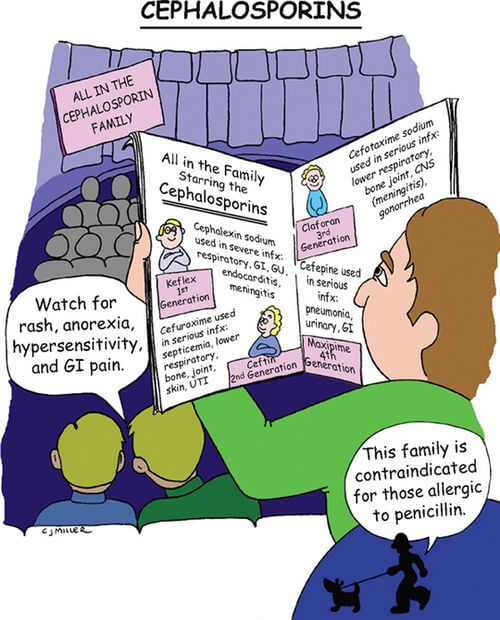Cephalosporins are one of the most widely prescribed antimicrobial drugs. They can be classified into 5 to generations and the medical students often have hard time remembering the names of drugs falling into different generations as the names appear and sound similar. This is a collection of mnemonics from different sources.
Classification of Cephalosporins
| 1st Generation | 2nd Generation | 3rd Generation | 4th Generation | 5th Generation | |||
| Oral | Parenteral | Oral | Parenteral | Oral | Parenteral | Parenteral | Parenteral |
| Ceph-a-lexin | Cef-a-zolin | Cef-a-clor (exception) | Cefuroxime | Cefixi-me | Cefotaxi-me | Cefi-pi-me | Cefta-ro-line |
| Cef-a-droxil | Cefuroxi-me axetil (exception) | Cefotetan | Cefpodoxi-me axetil | Ceftizoxi-me | Cefi-pi-rome | Ceftobip-ro-le | |
| Ceph-a-ridine | Loracarbef | Cefoxitin | Ceftibuten | Ceftriaxone | Cef-qui-nome | Cefto-lo-zane | |
| Cefprozil | Cefmetazole | Cefditoren | Ceftazidi-me | ||||
| Cefdinir | Cefoperazone | ||||||
| Moxalactam | |||||||
Mnemonic for Oral and Parenteral Cephalosporins
Parenteral:
- All 4th and 5th generation cephalosporins
- Have “t” except ceftibuten and cefditoren
- Having “z” – zone, zolin, zole
Oral: Have “OR” in the name – Cefaclor, Cefditoren, Loracarbef
Menmonic to remember classification by generation of Cephalosporins
A. 5th generation:
- With “ro” and “lo”: ceftobiprole, ceftaroline, ceftolozane
B. 4th generation:
- With “pi” and “qui”: Cefepime, Cefepirome, Cefquinome
C. 1st generation:
All cephalosporins having “A” after “Cef” are 1st generation except Cefaclor.
2 Xs and 1 Z in Dine
- 2 “X” – cefalexin, cefadroxil
- 1 “Z” – cefazolin
- 2 “IN” – cefalothin, cefaparin
- DINE – cephradine
D. 3rd generation:
Cephalosporins ending with “me” are 3rd generation except cefuroxime.
“cef” +/- (a,e,i,o,u) + p/d/t
- cefotaxime, ceftizoxime, ceftriaxone, ceftazidime, cefoperazone
- cefixime, cefpodoxime, cefdinir, ceftibuten, ceftamet
E. 2nd generation:
FURy FOX FOR FON TEA and 2 Ms for a Macho fox
- ceFURoxime, ceFOXitine, ceFORanide, ceFONicid, cefoTEtan
- cefMandole, cefMetazole
- Remember one more drug: Cefaclor
Flomoxef has been classified by different authors into different generations – 2nd, 3rd and 4th generations.
Short review of pharmacology of cephalosporins
A. Class: Beta-lactams (like Penicillin)
B. Mechanism of action: Disrupt cell wall synthesis by inhibiting transpeptidase (cross-linking)
C. Pharmacokinetics:
- Most are excreted by kideny (tubular secretion).
- 2 “Zones” are secreted in bile: Ceftriaxone and Cefoperazone
D. Blood brain barrier (BBB) penetration:
- 1st generation: No BBB penetration
- 2nd generation: Cefuroxime has highest among 2nd generation
- 3rd generation: Except Cefoperazone and Cefixime
E. Spectrum of activity:
| Generation | Gram Negatives | Gram Positives | β-Lactamase Stability |
|---|---|---|---|
| 1st | + | +++ | +/- |
| 2nd | ++ | ++ | + |
| 3rd | +++ | + | ++ |
| 4th | +++ | ++ | +++ |
| 5th | +++ | +++ | ++++ |
- 1st generation: Mainly Gram+
Gram – (PEcK): Proteus, E.Coli, Klebsiella
- 2nd generation: Gram- > Gram+
HEN PEcKS: Haemophilus influenzae, Enterobacter, Neissera, Proteus, E. Coli, Klebsiella, Serratia
- 3rd generation: Gram – >> Gram +
Ceftriaxone: Meningitis, Gonorrhea
Ceftazidime and Cefoperazone: Pseudomonas
Used to treat meningitis and sepsis (can cross Blood Brain Barrier) - 4th generation: Pseudomonas
- 5th generation: MRSA
Activity against Bacteroides:
- 2nd generation: Cefoxitin, Cefotetan and Cefmetazole
- 3rd generation: Ceftizoxime (maximum)
Activity agaisnt pseudomonas:
- Ceftazidime (maximum)
- Ceftazolone
- Cefoperazone
Cephalosporins don’t have activity against: “LAME”
- Listeria
- Atypicals (including Mycoplasma and Chlamydia)
- MRSA (Except 5th generation)
- Enterococci
F. Drug of choice:
- Surgical prophylaxis: Cefazolin
- Melioidiosis (Burkholderia psudomalleri): Ceftazidime
- Gonorrhea, salmonellosis (including typhoid), E. coli sepsis, Proteus, Serratia, Haemophilus and empirical therapy for bacterial
meningitis: Ceftriaxone - Pseudomonal CNS infection: Ceftazidime or Cefepime or Meropenem (For GU and GI infections – Fluoroquinolones and Aminoglycosides)
- Bacteroides: Metronidazole (Cefoxitin is an alternative along with clindamycin and chloramphenicol)
G. Adverse effects:
- Drugs with methylthiotetrazole group: Cefamandole, Cefoperazone, Cefotetan, Moxalactam
- Acts like oral anticoagulant (Vit. K antagonist): Bleeding (hypoporthrombinemia)
- Disulfiram like reaction
- Biliary sludging:
- Ceftriaxone
- Cefotaxime
- Taste disutrbance: Ceftobiprole
- Non-bloody red stools: Cefdinir
- Nephrotoxicity:
- Cephaloridine (highest nephrotoxicity)
- Cephalothin
- Neutropenia: Ceftazidime
- Thrombophlebitis (Parenteral)
- Diarrhea
- Anaphylaxis
Mnemonic: “DDT HAPeNS”
D – diarrhea
D – disulfiram like reaction
T – thrombophlebitis
H – hypoprothrombinemia
A – allergy (hypersensitivity)
P – pain (severe with i.m.)
N – nephrotoxicity
S – super infections with fungi
H. Summary mnemonics for generation of cephalosporins:
- First Generation = “FA/PHA”
- Second Generation = “Everything Else”
- Third Generation = “ONE/TEN/IME”
- Fourth Generation = “PI” and “QUI”
- Fifth Generation = “ROL”
He is the section editor of Orthopedics in Epomedicine. He searches for and share simpler ways to make complicated medical topics simple. He also loves writing poetry, listening and playing music.
